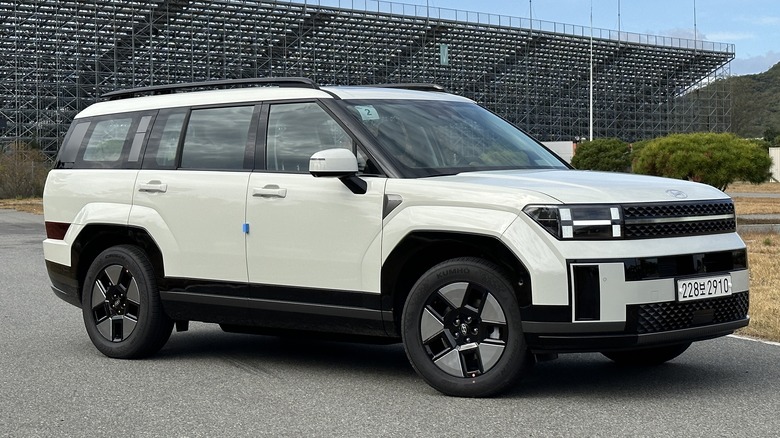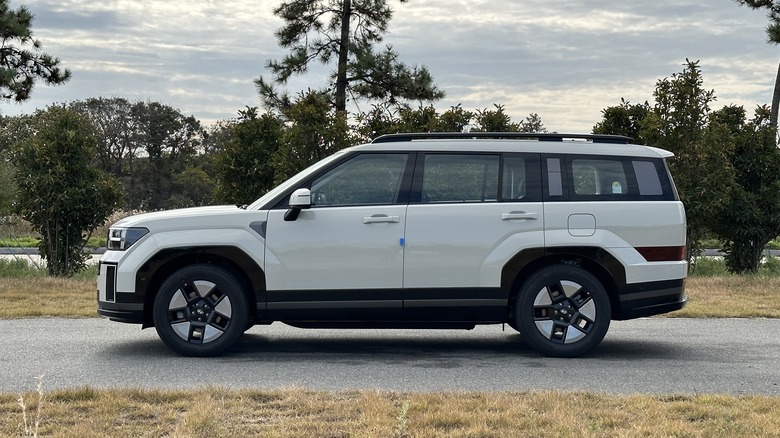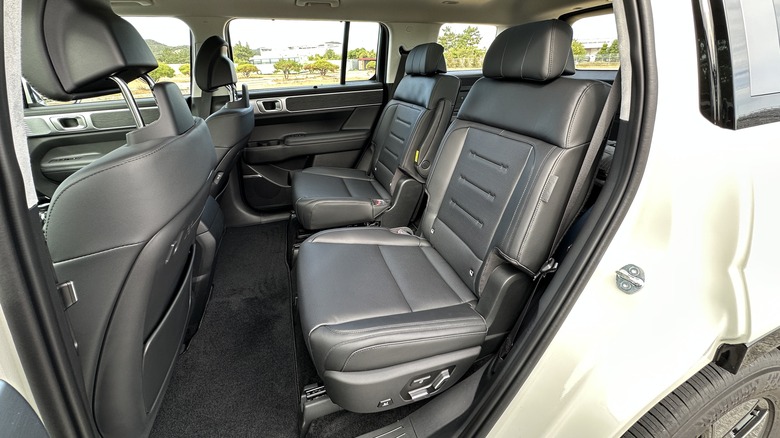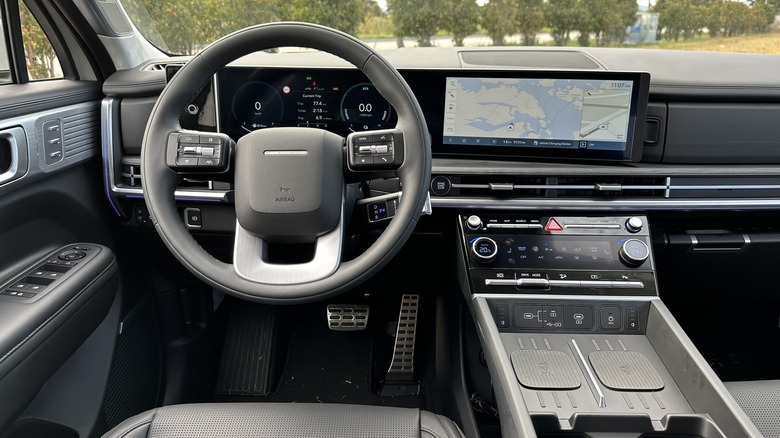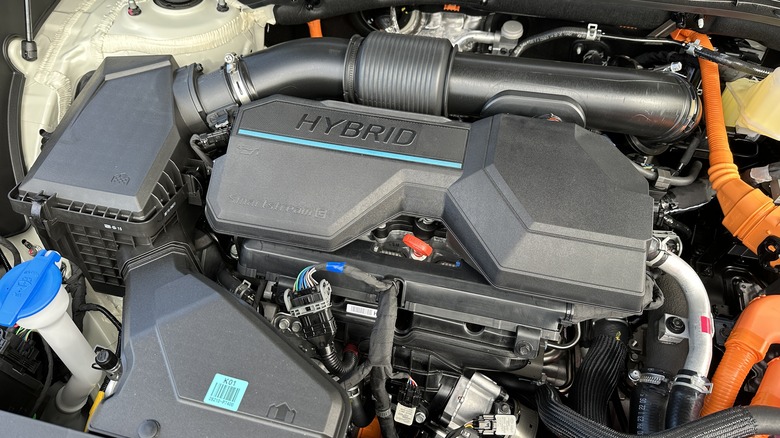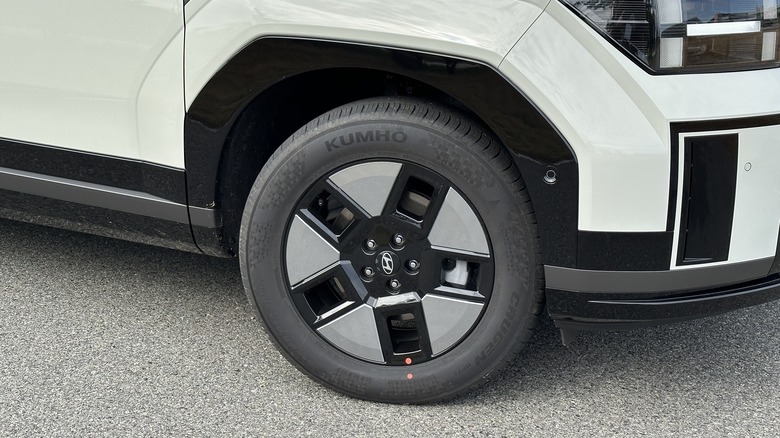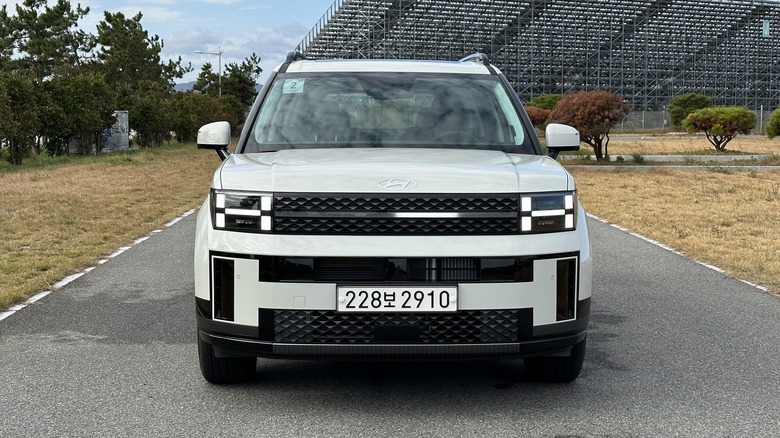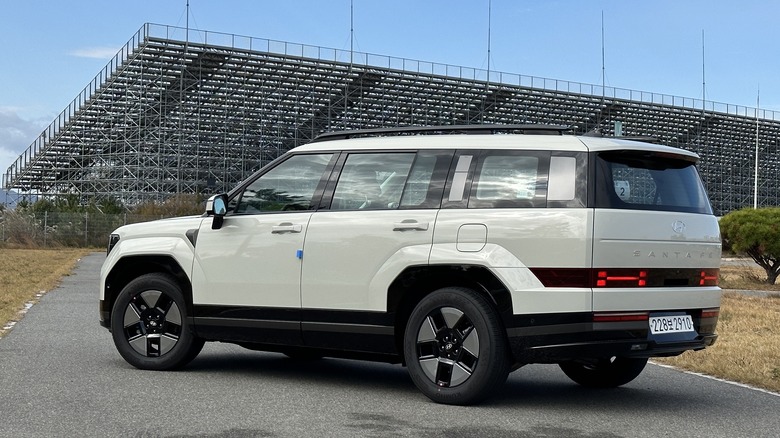2024 Hyundai Santa Fe First Drive: Three-Row SUV Gets A Striking Style Upgrade
No, that's not a Land Rover; you're looking at the spiffy new Hyundai Santa Fe. The seven-passenger Santa Fe got a major glow-up for the 2024 model year, adopting the sort of rugged good looks that American customers love while retaining this SUV's comfortable and composed on-road manners, premium interior trimmings, and excellent roster of in-car and driver-assistance tech.
The new Santa Fe won't hit North American showrooms until March 2024, but this SUV is already on sale in the company's home market: South Korea. So while the Santa Fe tested here isn't 100-percent representative of the final product that'll arrive in the US, it gives us a pretty darn good idea of what to expect. Just ignore those blue sponge door pads. It's a Korean thing.
Bigger and bolder
Boxy good looks definitely give the impression that the Santa Fe is a large SUV, though it's actually not much bigger than its predecessor. Measuring in at 190.2 inches long, 74.8 inches wide and 67.7 inches tall, the new Santa Fe is only 1.8 inches longer and 1.4 inches taller than the outgoing model, and exactly the same width.
There's added cargo capacity inside the Santa Fe as a result of this slight embiggening, with 40.5 cubic feet of space behind the second row. Hyundai touts a liftgate opening width of 50.2 inches, as well, which is 5.7 inches larger than the outgoing Santa Fe. Very helpful for all those inevitable Ikea and Costco runs.
There'll be a whole mess of trim levels offered Stateside, with wheels ranging in size from 18 to 21 inches. The smaller ones are what you see on this test car, and while the design is cool and modern, you really need the bigger wheels to fill out those generous wells. U.S.-spec models will have tinted rear windows, too, so don't be fooled by the Korean-market SUV in these photos. All those awesome LED lights will come to the US, though, as well.
More room for passengers
The Santa Fe's larger dimensions include a 1.9-inch longer wheelbase, which directly results in additional legroom. Indeed, passengers in all three rows of seats won't have issues stretching out, though the way-back is still too cramped for larger adults — not to mention tough to access.
Depending on the trim level, the 2024 Santa Fe offers seating for either six or seven passengers, with optional captain's chairs in the second row. Back-seat passengers even get their own separate sunroof on higher trim levels, which is great for giving the interior a light and airy vibe. That said, there are no rear-facing climate controls for the rear riders, which is a pretty weird omission.
There's no shortage of storage areas inside the Santa Fe, with a deep center console, large door pockets and two — count 'em, two — gloveboxes. Wireless charging pads for two smartphones are available as well, so both the driver and passenger can keep their devices juiced on the go.
There's good tech, too
A curved display atop the dashboard houses a pair of 12.3-inch high-res screens. On the left, you'll find the usual digital gauge cluster with reconfigurable graphics, and on the right, it's Hyundai's usual multimedia loadout. None of the infotainment software is vastly better than what's offered in Hyundai's current lineup of vehicles, but hey, big win: Apple CarPlay and Android Auto connect wirelessly. Finally.
Driver-assistance tech is also in high supply, but again, it's nothing Hyundai doesn't already offer. The usual goodies like blind-spot monitoring, forward-collision warning, adaptive cruise control, and lane-keeping assist are all here, as is Smart Cruise Control 2, which combines those last two features and adds lane-centering. Perhaps I should call that lane ping-ponging, though, given how this tech likes to bounce the Santa Fe between the lines on the highway.
Two engine choices, and one's a hybrid
Hyundai is planning a full range of powertrains for the 2024 Santa Fe worldwide, including two electrified options and even a diesel. In America, however, we'll have just two: one gas-only and one non-plug-in hybrid. A fully electric version is not planned, either, but Hyundai will soon offer the Ioniq 7 SUV, which will share much of its underpinnings with the Kia EV9.
The 2.5-liter turbocharged inline-4 and 8-speed automatic combo is my favorite; it offers the most power and the smoothest operation, and just generally feels the best from behind the Santa Fe's wheel. Output is rated at a respectable 277 horsepower and 311 pound-feet of torque. This is the powertrain Hyundai uses in several other vehicles, including the Santa Cruz truck.
Eco-minded shoppers can select a 1.6-liter turbocharged inline-4 paired with an electric motor and 6-speed automatic transmission, delivering a total of 232 hp and 271 lb-ft. This powertrain is... fine; it's not particularly powerful or engaging, and occasionally requires you to really put the hammer down to get this SUV moving. Fuel economy estimates aren't available just yet, but look for that information to be revealed closer to the Santa Fe's on-sale date in March 2024.
Pleasant on pavement
I'm limited in what I can say about the Santa Fe's dynamic performance, since the roads of South Korea are not only notoriously straight and flat, but also heavily congested and strictly speed regulated. But on a long drive from Seoul to Mokpo, the Santa Fe is super nice, with a good ride quality, excellent visibility and solid performance from the 2.5-liter engine.
The upright shape definitely accounts for some wind noise at higher speeds, and what few corners I was able to find did show that the Santa Fe exhibits noticeable body roll in corners. But at least the steering is nicely weighted, the brakes are solid, and the ride is comfortable — though more so with the larger-sidewall tires wrapping the 18-inch wheels than the lower-profile 21s.
Hyundai will sell a Santa Fe XRT trim in the US that offers a little bit of off-road capability, mostly thanks to its 245/60R18 all-terrain tires and 1.4 inches of additional ground clearance. There's no proper low-range all-wheel-drive setting or any mud/dirt drive modes, but the Santa Fe does have hill-descent control. When equipped with a tow package, the Santa Fe can pull 4,500 pounds.
Competitors and pricing
The Santa Fe competes in a tweener subset of SUVs: it's bigger than the compact Tucson, but smaller than what we Americans call a midsize Palisade. Think of it as an alternative to vehicles like the five-passenger Chevrolet Blazer, Jeep Grand Cherokee, Kia Sorento, or Honda Passport, squeezing in a third row of seats for greater flexibility but without the footprint of the Palisade above it in the range.
How much will the 2024 Santa Fe cost? That's also TBD, but don't expect any kind of mega price hike compared to the current model. That means a base version should start right around $30,000, with a fully loaded Calligraphy climbing up to $45,000. Like the fuel economy info, Hyundai will reveal final pricing data next March.
2024 Hyundai Santa Fe arrives next March
That focus on value is important: so far in 2023, the current Santa Fe has been Hyundai's second most popular model in the U.S., and it took that second place spot for 2022 sales too. If the existing SUV had a problem, it was at best unmemorable (and at worst, divisive) styling on the outside, and a dashboard and switchgear that looked dated compared to other models in the automaker's line-up.
That the 2024 Hyundai Santa Fe is a comfortable and competent midsize SUV is nothing new, then: this seven-passenger family-hauler has always been a compelling choice. But thanks to its bolder, more extroverted styling, the Santa Fe is poised to better stand out in an ever-crowded class of crossovers and SUVs. Sure, it looks like a Land Rover. But it's not like that's a bad thing.
